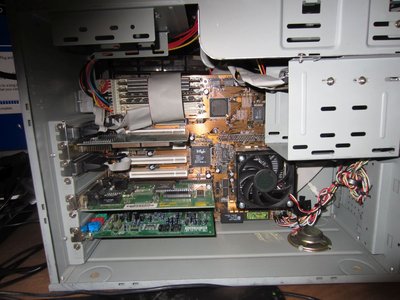First post, by kaputnik
- Rank
- Oldbie
Hello folks, new to the forums!
Been into retro hardware for a year or so now, finding that it's getting harder and harder to get favorites from my youth running on newer rigs, and also that there's a certain charm about original hardware. Scrounged old parts here and there, most of it from my own cellar, and built two retro rigs (haven't got room for more, sadly). The first one is geared towards performance, want to run games like Blood, Duke 3D, the older iterations of Quake, Tomb Raider, etc. at highest possible resolution and FPS. In short, a DOS/W98 monster. The second one is all about compatibility, want it to run anything I throw at it, except the "newer" games I play on the monster.
This is what I've put together so far. I'm pretty satisfied, but as usual, I believe there's room for improvement. I get the impression that there's an immense and detailed knowledge of almost anything retro hardware on these boards. What do you think, is there anything to be done from here? I'm interested in any suggestions, no matter how small the improvements would be, I'm quite the perfectionist when it comes to this kind of stuff.
The monster rig:
Mobo - Chaintech 7AJA2. A quite nice KT133A board, supporting ATA100. Back in the days I had an Asus A7 Pro I just can't find. Must have thrown it away at some point.
CPU - Athlon XP 2400+ (Thoroughbred)
RAM - 512 MB Samsung PC133 SDRAM.
Graphics - Nvidia P83 128M, a Geforce4 Ti 4600 card. Also got my old Diamond Multimedia Monster 3D II (Voodoo 2) hooked up.
DOS sound - SB Awe 64 Gold (CT4390). No memory expansion.
Windows sound - SB Live! (CT4830).
Storage - Some Seagate 40GB ATA100 drive. It's surprisingly silent to be from that time. DVD reader.
NIC - cheap noname card with Realtek RTL8139 chipset. Got better NICs performance wise, but I really like those Realtek ones. No problems whatsoever, and there are lightweight drivers without bloated manager software, etc, for just about any OS.
Case - Cooler Master Elite 361. One of the smallest possible full ATX cases. I really like this one for retro purposes, though it might be a little bit too modern looking for the purist.
PSU - Corsair CX500. Yes I know, not the best PSU ever, and way too big for this computer 😀 It was a bargain though, got it at less than half the regular price, and considering the low load, it shouldn't break anytime soon.
OS - Windows 98 SE with the latest unofficial service pack.
The compatible rig:
Mobo - Gigabyte GA-586HX rev. 1.53. As the name suggests, it's a Socket 7 430HX board. I do not have the extra modules needed to cache more than 64 MB ram. The unpopulated USB header is an oddity, there are no pins to connect an USB port to. I've tried to enable USB in BIOS, and W98 detects the controller. Probably/hopefully just a question of soldering in a pinheader the next time I take the computer apart? Planning to replace the FSB frequency and multiplier dipswitches with pinheaders at some point, and move the dipswitches to one of those expansion slot covers, to be able to underclock without opening the case. Guess I'll just solder in a pinheader for the USB ports while I'm at it. If it doesn't work, no big deal, it's not like I really need those ports.
CPU - Pentium 200, with a socket A cooler and a home made custom fan shroud, enabling the use of a 70mm fan fed with ~7 volts. Extremely silent.
RAM - 64 MB 60ns EDO ram.
Graphics - S3 Trio64+ PCI, Diamond Multimedia Monster 3D (Voodoo 1).
Sound - SB Awe 32 (CT3670), expanded with 4 MB ram.
Storage - 16 GB 266x CF card, through an CF-IDE adapter. Using a hacked bios to get past the size boundaries. Also threw in some random floppy drive and a CD reader, mostly cosmetics to get right look 😀
NIC - 3com 509B.
Case - some random ugly cream white Baby AT tower, very typical of its time.
PSU - Seventeam ST-230WHF. Obviously an AT PSU. Inside, it actually looks very well made. High quality components, generously dimensioned heat sinks, etc. Quite surprising, as it's from a time when next to noone cared about the PSU, and just went with whatever crap that was bundled with the case.
OS - Windows 98 SE with the latest unofficial service pack.
Both computers share a Qpad MK50 keyboard, a Logitech MX400 laser mouse, and a Samsung Syncmaster 913N (19", 4:3 aspect ratio, 8ms refresh LCD) via an Aten CS62A KVM switch. Not really retro stuff, but I don't have room for a CRT on my desk, and really, new keyboards and mice are - with a few rare exceptions - at least in my opinion better than the stuff from that time 😀
So guys, any ideas? 😀
By the way, here are a couple of pics of the rigs, if someone's interested. The pic of the compatible rig is from when I first built it (kinda hard to get it out from the corner where it is now to snap new photos), sorry about the non existant cable management. The Vibra16 card is since then replaced with an Awe32.
The monster...
...and the compatible one.

